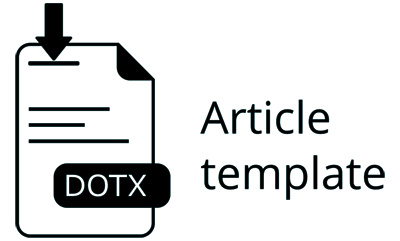STUDI PENGEMBANGAN LAHAN RAWA LEBAK POLDER ALABIO HULU SUNGAI UTARA KALIMANTAN SELATAN
Abstract
The potential and area of swamps in Indonesia are very large, but the development of swamps is still small. The key success factor in swamps development lies in the water management system. The Alabio polder is the result of the development of a nontidal swamp with a polder system with an area of ± 6000 Ha located in the Alabio area, Danau Panggang District, South Kalimantan. Until now, Polder Alabio has not been working optimally, so rice production in this land has not been as expected. This paper aims to identify problems in the development of the Alabio Polder nontidal swamp. The method used in this study is to use literature studies taken from various scientific sources, either in the form of scientific articles, activity reports/studies related to the Alabio Polder. The study results showed that the water management at the Alabio Polder is still not functioning optimally. The main problems in the development of the Alabio Polder are the irrigation, drainage, and water structures that are not functioning properly, as well as the maintenance that has not been carried out routinely and properly. Irrigation channels, drainage, and water structures that do not function properly cause the quantity of water (discharge) to not be flowed properly to the entire land so that it also impacts the water quality in the land which is not good. Some solutions that can be done to overcome the problems at the Alabio Polder are to carry out regular and periodic repairs and maintenance of irrigation and drainage channels as well as maintenance of water buildings in the Alabio Polder.
References
Anonim. (2012). SNI 1726:2012 tentang Tata Cara Perencanaan Ketahanan Gempa untuk Struktur Bangunan Gedung dan Non Gedung. Jakarta: Badan Standardisasi Nasional.
Anonim. (2015a). Peraturan Pemerintah Nomor 29 Tahun 2015 Tentang Rawa. Jakarta: Kementerian Pekerjaan Umum dan Perumahan Rakyat.
Anonim. (2015b). PIRIMP Participatory Irrigation Rehabilitation - Improvement Management Project: Sub-Proyek – Alabio di Kalimantan Selatan. Direktorat Jenderal Sumber Daya Air. Nippon Koei Co., Ltd. In association with PT. Virama Karya, PT. Indra Karya, PT. Tata Guna Patria, PT. Kwarsa Hexagon, PT. Wiratman & Associate.
Anwar, K., Susilawati, A., & Noor, M. (2012). Laporan Hasil Penelitian Tahun Anggaran 2012-2013. Balai Penelitian Lahan Rawa.
Arfiadi, Y. (2016). Diagram Interaksi Perencanaan Kolom dengan Tulangan pada Empat Sisi Berdasarkan SNI 2847:2013 dan ACI 318M-11. Jurnal Teknik Sipil, 13(4), 268–290.
D, Y. R. (2017). Dinamika Kelompok Perkumpulan Petani Pemakai Air di Lahan Rawa Lebak. SEPA: Jurnal Sosial Ekonomi Pertanian Dan Agribisnis, 11(2), 235. https://doi.org/10.20961/sepa.v11i2.14186
Djamhari, S. (2009). Penerapan Teknologi Pengelolaan Air di Rawa Lebak Sebagai Usaha Peningkatan Indeks Tanam di Kabupaten Muara Enim. Jurnal Hidrosfir Indonesia, 4(1), 23–28.
Fuadi, R. A., Daud, S., & Peratenta, M. (2015). Pengaruh Konsentrasi Chemical Agent (Detergent, NaOH) dan Tekanan Trans-Membran pada Pencucian Membran dari Proses Pengolahan Air Gambut Secara Cross Flow. JOM FTEKNIK, 2(2), 1–6.
Irwandi, D. (2015). Analisis Sistem Komunikasi Usaha Tani Padi-Jeruk di Lahan Pasang Surut Kalimantan Tengah. Agrica Ekstensia, 9(1), 8–15.
Muhaimin. (2016). Bisnis Wirausahawan Muslim Alabio Studi Kasus di Kota Banjarmasin. International Conference on Social and Intellectual Transformation of the Contemporary Banjarese, 1–19.
Noor, M., Anwar, K., & Kartiwa, B. (2019). Sistem Polder untuk Pengembangan Pertanian Berkelanjutan di Lahan Rawa Lebak.
Nugroho, H., Kurniani, D., Asiska, M., & Nuraini, N. (2016). Kajian Kinerja Sistem Polder sebagai Model Pengembangan Drainase Kota Semarang Bagian Bawah dengan Balanced Scorecard. MEDIA KOMUNIKASI TEKNIK SIPIL, 22(1), 43. https://doi.org/10.14710/mkts.v22i1.12508
Nugroho, V. (2012). Evaluasi Sistem Polder Kota Lama dan Bandarharjo Semarang Terhadap Pengendalian Banjir dan Ron. Surakarta: Universitas Sebelas Maret.
Rahmawati, E., Rahmawati, A. W., Suripin, S., & Kurniani, D. (2017). Pegembangan Drainase Sistem Polder Sungai Sringin ota Semarang. Jurnal Karya Teknik Sipil, 6(1), 281–290.
Rianto, N. (2012). Penyusunan Aspek Organisasional Pengelola Polder Studi Kasus: Kali Banger, Kota Semarang. Widyariset, 15(1), 39–48.
Roemiyanto, F. M. (2013). Konsep Teknologi Sistem Polder untuk Pelestarian Stasiun Semarang Tawang. Jurnal Teknik Sipil, 6(1), 1–7.
Rusdiansyah, A., Fitriati, U., Chandrawidjaja, R., & Rahman, A. A. (2019). Dasar Pengembangan Lahan Rawa. Banjarmasin: Lambung Mangkurat University Press.
Solikin, Suhartanto, E., & Haribowo, R. (2017). Penanganan Genangan dengan Sistem Polder pada Wilayah Kota Banjarmasin. Jurnal Teknik Pengairan, 8(1), 15–25.
Sulaeman, Y., Poggio, L., Minasny, B., & Nursyamsi, D. (2018). Tropical Wetlandsa-Innovation in Mapping and Management. Proceedings of the International Workshop in Mmapping and Management, 210. Banjarmasin: CRC Press.
Suriadikarta, D. A. (2012). Teknologi Pengelolaan Lahan Rawa Berkelanjutan: Studi Kasus Kawasan Ex PLG Kalimantan Tengah. Jurnal Sumberdaya Lahan, 6(1), 45–54.
Wahyuningsih, C. A., Estiana, R., Darsono, S., & Nugroho, H. (2017). Perencanaan Sistem Polder Tambak Lorok Semarang Utara. Jurnal Karya Teknik Sipil, 6(1), 314–323.
Zulfan, J., & Hana, M. A. (2013). Pengelolaan Polder Banger Berbasis Kebersamaan Antar Stakeholder. Jurnal Sosial Ekonomi Pekerjaan Umum, 5(1), 39–50.
Authors who publish with this journal agree to the following terms:
- Authors retain copyright and grant the journal right of first publication with the work simultaneously licensed under a Creative Commons Attribution License that allows others to share the work with an acknowledgement of the work's authorship and initial publication in this journal.
- Authors are able to enter into separate, additional contractual arrangements for the non-exclusive distribution of the journal's published version of the work (e.g., post it to an institutional repository or publish it in a book), with an acknowledgement of its initial publication in this journal.
- Authors are permitted and encouraged to post their work online (e.g., in institutional repositories or on their website) prior to and during the submission process, as it can lead to productive exchanges, as well as earlier and greater citation of published work (See The Effect of Open Access).
 Abstract viewed = 938 times
Abstract viewed = 938 times
 PDF downloaded = 4071 times
PDF downloaded = 4071 times










